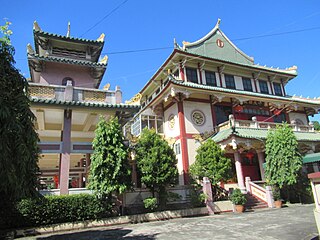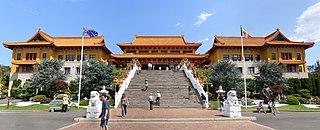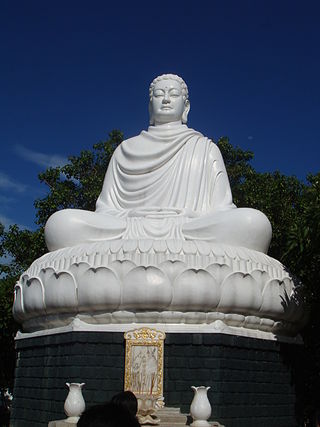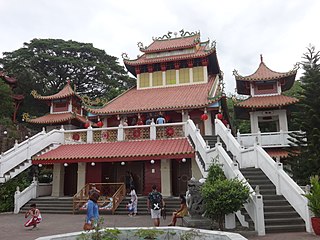
Mindanao is the second-largest island in the Philippines, after Luzon, and seventh-most populous island in the world. Located in the southern region of the archipelago, the island is part of an island group of the same name that also includes its adjacent islands, notably the Sulu Archipelago. According to the 2020 census, Mindanao has a population of 26,252,442 people, while the entire island group has an estimated population of 27,021,036 according to the 2021 census.

Davao City, officially the City of Davao, is a highly urbanized city in the Davao Region, Philippines. The city has a total land area of 2,443.61 km2 (943.48 sq mi), making it the largest city in the Philippines in terms of land area. It is the third-most populous city in the Philippines after Quezon City and Manila, and the most populous in Mindanao. According to the 2020 census, it has a population of 1,776,949 people.

The Longhua Temple is a Buddhist temple dedicated to the Maitreya Buddha in Shanghai. Although most of the present day buildings date from later reconstructions, the temple preserves the architectural design of a Song dynasty (960–1279) monastery of the Chan School. It is the largest ancient temple complex in the city of Shanghai.

The True Buddha School is a Buddhist sect founded in the 1970s. While predominantly focused on Tantric Buddhist teachings and practices, it also includes practices and deities from Taoism. Its headquarters are in Redmond, Washington, USA, and the school has a large following in Taiwan and East Asia. There are also many temples and chapters worldwide. In China, the sect is reportedly on a list of banned religious organisations.

Recent archaeological and other evidence suggests Hinduism has had some cultural, economic, political and religious influence in the Philippines. Among these is the 9th century Laguna Copperplate Inscription found in 1989, deciphered in 1992 to be Kawi script with Sanskrit words; the golden Agusan statue discovered in another part of Philippines in 1917 has also been linked to Hinduism.

Buddhism is a minor religion in the Philippines. It is practiced by 2% of the population in 2020, primarily by Filipinos of Chinese descent.

Rạch Giá is a provincial city and the capital city of Kiên Giang province, Vietnam. It is located on the Eastern coast of the Gulf of Thailand, 250 kilometres (160 mi) southwest of Ho Chi Minh City. East of city, it borders Tân Hiệp and Châu Thành town, the Gulf of Thailand is to the West and surrounds some parts of the city, south of the city is Châu Thành and An Biên town, and to the North it borders Hòn Đất and Tân Hiệp.

In Australia, Buddhism is a minority religion. According to the 2016 census, 2.4 percent of the total population of Australia identified as Buddhist. It was also the fastest-growing religion by percentage, having increased its number of adherents by 79 percent between the 1996 and 2001 censuses. The highest percentage of Buddhists in Australia is present in Christmas Island, where Buddhists constitute 18.1% of the total population according to the 2016 Census. Buddhism is the fourth largest religion in the country after Christianity, Islam and Hinduism.
Chung Tai Shan is a Taiwan-based international Chan Buddhist monastic order founded by the Ven. Wei Chueh in 1987. The monastery headquarters, Chung Tai Chan Monastery, completed in September 2001, is located in Puli, Nantou County, in central Taiwan. It is the tallest and one of the largest monasteries in both Taiwan and the world, having a height of 136 metres (446 ft). Widely admired as an architectural masterpiece because of the mountain monastery's more modern look, the temple is second only to Fo Guang Shan's monastery in physical size and in the number of ordained disciples.

Ajima is a group of goddesses of the Newar pantheon. These goddesses are respected by all sects and castes of Newars, both from Hindu and Buddhist religion. If we look Ajimas from sky, they look like a sword. So, it is said that the Ajimas protect Kathmandu Valley.

Fo Guang Shan Mabuhay Temple is the Philippine branch of the Taiwan affiliated Fo Guang Shan Buddhist Order in the Philippines. As do all branch temples, way-places, and organizations of Fo Guang Shan, the branch follows Humanistic Buddhism, a modernized style of Buddhist teaching as propagated by Hsing Yun, spiritual founder and teacher of the order.
Indians in Vietnam consist of migrants to Vietnam from India, both historical and recent. As of 2011, there were about 2,000 people of Indian origin settled in Vietnam, mainly in Ho Chi Minh City. Prior to the Vietnam War, there was a vibrant Indian community consisting of primarily Tamils, and specifically the Chettiars.

Thích Ca Phật Đài is a notable Theravada Buddhist temple in the coastal city of Vung Tau in southern Vietnam. It lies to the northwest of the Lớn mountain and was built between 1961 and 1963 when it was opened.

A wat is a type of Buddhist and Hindu temple in Cambodia, Laos, East Shan State, Yunnan, the Southern Province of Sri Lanka, and Thailand. The word wat is borrowed from the Sanskrit vāṭa, meaning "enclosure". The term has varying meanings in each region, sometimes referring to a specific type of government-recognised or large temple, other times referring to any Buddhist or Hindu temple.

A sandō in Japanese architecture is the road approaching either a Shinto shrine or a Buddhist temple. Its point of origin is usually straddled in the first case by a Shinto torii, in the second by a Buddhist sanmon, gates which mark the beginning of the shrine's or temple territory. The word dō (道) can refer both to a path or road, and to the path of one's life's efforts. There can also be stone lanterns and other decorations at any point along its course.

The Ma-Cho, Mazu or Ma Cho Temple is a Taoist temple to the Chinese Sea-Goddess Mazu located on Quezon Avenue in Barangay II, San Fernando, La Union in the Philippines. It was built in 1977 by a group of Filipino-Chinese devotees under the leadership of Dy Keh Hio and with the support of former Tourism Secretary Jose D. Aspiras.

Chinese folk religion plays a dynamic role in the lives of the overseas Chinese who have settled in the countries of this geographic region, particularly Burmese Chinese, Singaporean Chinese, Malaysian Chinese, Thai Chinese and Hoa. The Indonesian Chinese, by contrast, were forced to adopt en masse either Buddhism or Christianity in the 1950s and 1960s, abandoning traditional worship, due to Indonesia's religious policies which at the time forbade Chinese traditional religion or did not recognize it as a "religion" thus making it vulnerable to discrimination. Some Chinese Filipinos also still practice some Chinese traditional religions, besides Christianity of either Roman Catholicism or Protestantism, of which some have also varyingly syncretized traditional Chinese religious practices with. Chinese folk religion, the ethnic religion of Han Chinese, "Shenism" was especially coined referring to its Southeast Asian expression; another Southeast Asian name for the religion is the Sanskrit expression Satya Dharma.

The Davao Chinatown is the Chinatown located in Davao City and the only one in Mindanao. It is the primary residential area of the Chinese Philippine community in the city. The area is bordered by Santa Ana Avenue, Monteverde Avenue, Ramón Magsaysay Street and León García Street. It is the Philippines' largest Chinatown by area with a total land area of 44 hectares and is part of four barangays.

The Bell Church is a Chinese Filipino indigenous religious organization based in La Trinidad, Benguet, Philippines. It is led Elias Ng, the Spiritual Leader and Head Administrator of the Bell Church.


















